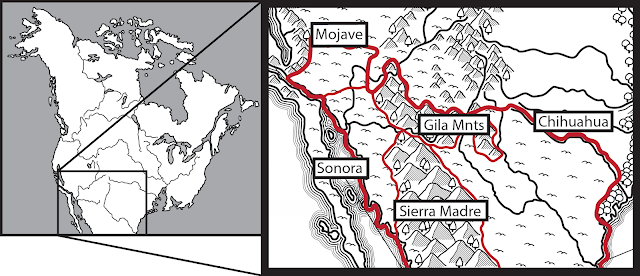GNA - Arctic Archipelago
The harshest environment of North America, this region includes all of the non-tree baring islands of the Arctic ocean. Once covered in permafrost, which helped to trap moisture in the ground, the warmer southern months have allowed this water to escape turning it into a frigid desert. Its flora, where it occurs, consists mostly of herbs, lichen, and dwarf shrubs
The Arctic archipelago has a frigid semi-arid climate with short, cool summers and long, cold winters. Average daily temperatures in the summer are 10 C while in winter they average less than -30 C. Annual precipitation ranged from about 300mm to 500mm. Highlands, mostly bare rock, are unable to hold water and so it tends to pool in low-lying lakes, rivers, and muskegs. Most characteristic of the climate of the far north is the immense seasonal fluctuation in the length of daylight. In the warmest months the sun can stay above the horizon for days, weeks, or even months at a time nearest the pole. Similarly, throughout the winter there are long stretches of darkness. This dark is often lit by the aurora - an awesome display of dancing green, blue, and crimson light.
The northern islands are dominated by wide flat plains that extend as much as 10km inland and broad plateaus rising in their interiors. On some islands the plateaus extend to the sea leading to coasts edged by tall cliffs, inaccessible to boats. Regardless, all the land is littered with sand, gravel, and boulder debris left by melting glaciers. Along the crests of the inland plateaus it is common to see deep v-shaped cuts where steams have cut into the stone.
Plant life across the arctic is sparse and stunted due to the cold temperatures and the general lack of osil and water. The island can be divided between two general kinds of plant life. The first occurs on rocky uplands which tend to be bare rock or dotted with sedges, mosses, and lichen. The second in lowlands, valleys, and streams where plants grow more thickly and there are dwarf shrubs such as alder, arctic willow, and dwarf birch. These shrubs never grow much larger than a few feet.
Fearsome Critters: arctic wolf-dog, grolar bear, wolverine
Big Game: caribou, muskox
Small Game: ermine, fox, hare, lemming, weasel
Fowl: bunting, duck, goose, gull, gyrfalcon, hawk, jaeger, loon, owl, plover, ptarmigan, redpoll, sandpiper
Fish: char, cisco, grayling, lamprey, nelma, salmon, sculpin, trout, whitefish
Fitting for the harness of its climate, the Arctic islands are one of the least populated areas of North America. Its population density is extremely low, as little as 1 person every 40 square miles. Farming is impossible on the rocky ground of the islands and while hunting and trapping are useful supplements to diet, it is from the sea that the people of the Arctic earn their subsistence. To other groups the Arctic serves as a layover place, especially in trade expeditions along or across the Arctic circle. Fortified tradeposts appear occasionally in sheltered bays acting as supply poionts for tradeships or lairs of local pirates. These frontier outposts depend entirely on a mixture of trade with local people and imported foodstuffs to supply their meager garrisons.









Comments
Post a Comment